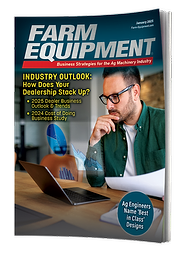A Farm Equipment Special Report: What Will Agriculture Look Like in 2021?
Big planters will still exist in the future, says Jeff Schick of Eaton Corp., but we'll want them to be more precise than ever.
"When pulling a 60-foot or larger planter, you're going to want to vary seeding populations, fertility rates and even down-pressure from one end of the planter to the other. We're already doing prescription control, but in the future there will be more onboard electronics providing increased accuracy resolution," he says.
Increased accuracy will likely come in the way of individual row control on the planter, says Tom Evans of Great Plains Manufacturing.
"Instead of the entire width of the planter delivering the same population, each row will be delivering the correct population and fertility rate based on mapped recommendations," Evans says.
Fertility and yield maps don't produce neat, tidy and convenient planter-wide recommendations. There are many times in planting operations where planter sections overlap map lines into areas that would produce better with a different plant population or fertility inputs. The guidance and the accuracy are already available. The next stage in planter development will need to come from equipment engineers.
"How fast the shaft turns determines planting populations. We can turn individual rows off and on with row clutches, but we can't control individual planting populations because one shaft drives large sections of the planter," Evans explains. "In the future, we'll see individual row drives on planters so shaft speeds, and therefore populations, can be adjusted on a per-row basis."

|
| Kinze’s autonomous planting system (pictured in a demo here) is a possibility for the 2020s, but individual row control to dial up accuracy is almost a certainty, experts say. |
Rows one and two may be planting 32,400 seeds per acre, while rows three, four and five are putting out 35,000 seeds per acre.
"When planting $300-a-bag-seed, population needs to be matched to fertility and the soil's ability to produce," Evans says. "It's this fact that will push individual row control for planting populations and fertility. It should be in full swing in the next 10 years."
The fact that planters continue to get larger will definitely help push this technology, too, says Al Myers of Ag Leader Technology.
"Farmers are smart enough to know there are changes in soil conditions across the 120-foot working width of the huge planters available today," he says. "There are even changes in planters of 8-rows or less. The electronics are available. We just need the machine to have the capability to adjust by the row."
Electronics also are capable of planting multiple hybrids from one planter. However, the machine capability isn't there. Evans doesn't believe there will be enough demand to drive development of this technology in the next decade.
The Fast Track
Exceeding 5 mph while planting never happens, right? Well, in 2021 when the clouds are rolling in and there are 20 acres left to plant, producers will likely be able to grab another gear and go for it.
"Speed is a killer for accurate planting," Evans says. "Resulting poor spacing can cause lost ears and have a major impact on the bottom line. The demand is there to drive the development of planters that can accurately plant seed at more than 5 mph."
Planters will speed along on a controlled track, too, he says.
"Controlled traffic is going to be more popular and it will push manufacturers to produce more 3-point mounted and stacked planters that follow along precisely behind the tractor," Evans says.
When combined with individual row control for planting populations and fertilizer, controlled traffic also will open up a whole new world for implement steering, he says. Drifting even a few inches off the tramline on a hill will be unacceptable when such a precise level of accuracy is the goal.
Row Spacing: Narrow, Geometric or Adjustable?
Changes in row spacing may make controlled traffic even more necessary.
"Row spacing is going to totally change in the next 10 years. There shouldn't be any 30-inch rows. It's likely that 30-inch rows or narrower will be the row spacings of choice," Evans says.
Adaptability will be a key planter design in the future, says Brian McKown of Kinze Manufacturing.
"Twenty years ago, planting operations were the same in Iowa as they were in Illinois, but today we understand there are significant differences from geography to geography, and planting operations need to be different, too," he says. "We'll have to provide a product that is adaptable. Row width will need to be adjustable."
McKown pictures a planter that can plant 30-inch rows in one field and — with a few quick changes — plant 20-inch rows in another field.
"Farms are getting larger. Sometimes farmers' fields are spread across a 50-square mile area. Terrain can vary from flat river bottoms to terraces and they need to be able to adapt row spacing and configuration from field to field and crop to crop," he says.
Raj Khosla, professor of precision agriculture at Colorado State Univ., says row spacing might give way to plant spacing.
"There's a lot of discussion and experimentation going on with equally spaced plants," Khosla says. "In the future, there may not be rows, but precision placement of plants in geometries so that each plant has an equal amount of space on all sides."
Instead of plants 4 inches apart separated by 30-inch rows, each plant would have equal spacing on all sides. Accomplishing this feat of doing away with rows would require a change in how equipment moves over the field. Robotics could be one option, Khosla says, or possible creating tram lines for equipment to track along instead of following rows.
In-Field Tech Support
Planter monitors and controllers are a big frustration for producers that use them all of two weeks per year. They want the technology, Evans says, but dealing with this technology can be very frustrating. Controllers of the future will be more user-friendly and will save producers big money.
"A cell link to the monitor and controller will allow tech support to remotely run through the system while it's still in the field to see what caused a false reading or an error message," Evans says. "It will save hours and the expense of having someone from the dealership come out to do diagnostics."
Myers reports that only 10% of the service calls Ag Leader Technology receives actually need a part or real repair. The rest are just for tech support.
"With wireless technology, we'll be able to troubleshoot from the office or a mobile service truck without driving out to the machine. This technology will be available on every piece of complex machinery and will greatly increase the number of producers a dealer is able to service in a day," he says.
Back to September 2011 Issue Homepage






